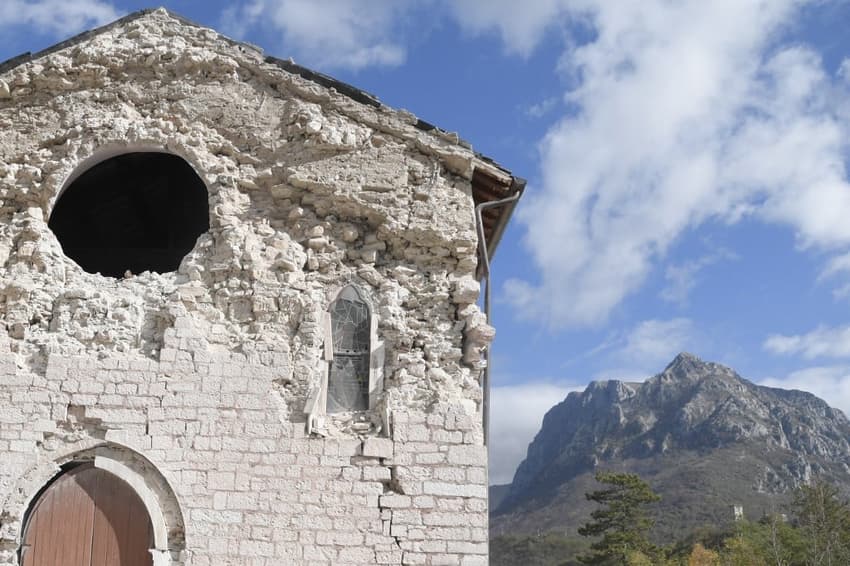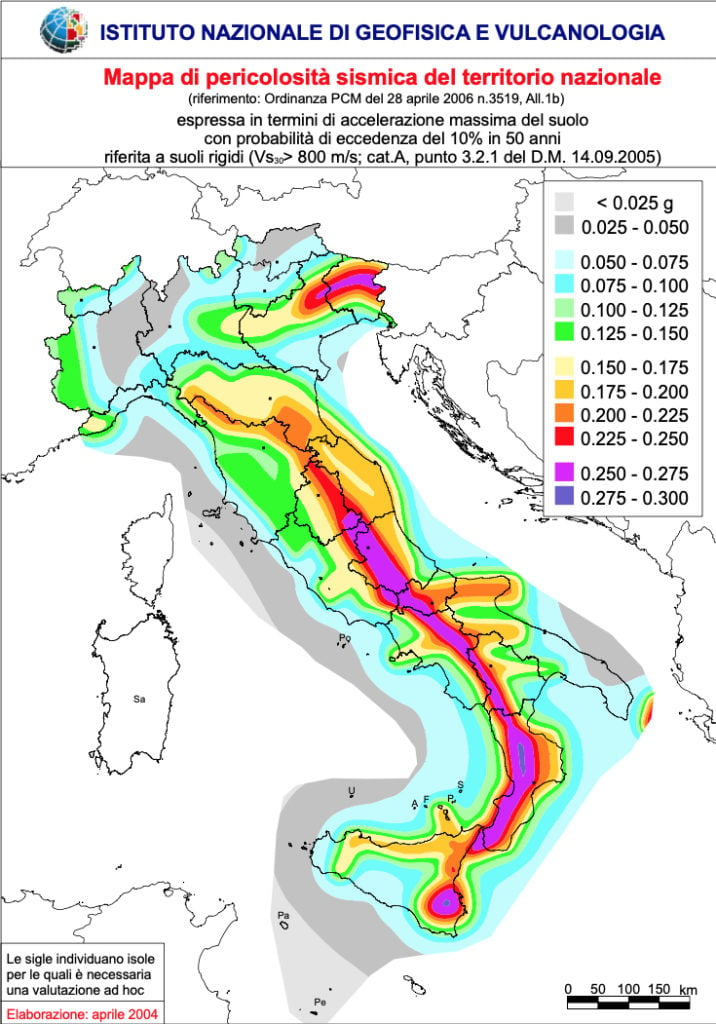IN MAPS: Which parts of Italy have the highest risk of earthquakes?

Italy is among the most earthquake-prone countries in Europe, but some areas are at higher risk than others.
Earthquakes are a common occurrence in Italy, and an inescapable part of life in the country - but they're more of a concern in some areas than others.
Italy has been hit by more than 30,000 'medium to strong' earthquakes over the past 2,500 years, and seven earthquakes with a magnitude of 6.5 or more in the 20th century alone.
Italy is among the European countries most at risk from earthquakes, according to mapping by the European Facilities for Earthquake Hazard and Risk (EFEHR).
Earthquake map of Europe.
Didn't think Italy or Romania would be so red.
By @EFEHR_tweets pic.twitter.com/YfiN2npeij
— François Valentin (@Valen10Francois) February 7, 2023
The Italian peninsula lies right where the African tectonic plate converges with the Eurasian plate, meaning the country is “seismic in its entirety”, according to the country’s Civil Protection Department.
Italy's National Institute for Geophysics and Volcanology (INGV) estimates that the “strongest earthquakes [...] can be expected in Calabria, south-eastern Sicily, Friuli Venezia-Giulia and along the central and southern Apennines”.
However there’s also significant risk in Puglia’s Salento peninsula, the Tyrrhenian coast of both Tuscany and Lazio, the Po Plain and the Alpine range, the institute states.
As for low-risk areas, Sardinia is the Italian region with the lowest seismic hazard.
Variations in seismic risk levels across Italy. Photo by National Institute for Geophysics and Volcanology (INGV).
The map above shows the variation in risk levels across Italy. Lower-risk areas are shown in light blue, green or yellow. Areas with a greater seismic hazard are orange, red or purple.
‘Seismic hazard’ (pericolosità sismica) is the main parameter used by authorities to gauge the risk of earthquakes in a certain area. This looks at the frequency and power of the quakes that hit a specific area over a set period of time.
READ ALSO: What to do in an earthquake in Italy
Essentially, the more frequent and the more powerful seismic events are, the greater the level of seismic hazard in the area.
It’s worth noting that, for scientists, the term ‘seismic hazard’ is not the same thing as ‘seismic risk’, which is defined as an overall assessment that takes several parameters into account, only one of them being seismic hazard (more on this below).
While seismic hazard is the most commonly used parameter when it comes to assessing the risk of earthquakes in a certain area, authorities take other factors into account.
Italy’s Civil Protection Department also looks at an area’s ‘vulnerability’ i.e. the propensity of the area’s buildings to be severely damaged by a quake, and ‘exposure’, meaning the total number of people and assets that would be endangered by a seismic event in the area in question.
Updated #earthquake #hazard map and, for the first time, an earthquake #risk map for Europe by European scientistshttps://t.co/nkyvNRqUzP pic.twitter.com/4An0WTXiSs
— SafeGreece (@SafeGreece) May 2, 2022
According to the Civil Protection Department, Italy doesn’t just have a “medium-high seismic hazard” but also “high vulnerability” due to the fragility of its infrastructure and “very high exposure” on account of the country’s population density and the many historical and artistic assets found across the territory.
When combined, these three factors (seismic hazard, vulnerability, exposure) allow for a comprehensive assessment of a country’s overall seismic risk.
In Italy’s case, the peninsula has “a high seismic risk”, with quakes likely to result in loss of human life and significant damage to local infrastructure.
Without accounting for damage to historical and artistic assets, the economic cost of damage caused by seismic events over the last 40 years in Italy is estimated at around 80 billion euros.
Comments
See Also
Earthquakes are a common occurrence in Italy, and an inescapable part of life in the country - but they're more of a concern in some areas than others.
Italy has been hit by more than 30,000 'medium to strong' earthquakes over the past 2,500 years, and seven earthquakes with a magnitude of 6.5 or more in the 20th century alone.
Italy is among the European countries most at risk from earthquakes, according to mapping by the European Facilities for Earthquake Hazard and Risk (EFEHR).
Earthquake map of Europe.
— François Valentin (@Valen10Francois) February 7, 2023
Didn't think Italy or Romania would be so red.
By @EFEHR_tweets pic.twitter.com/YfiN2npeij
The Italian peninsula lies right where the African tectonic plate converges with the Eurasian plate, meaning the country is “seismic in its entirety”, according to the country’s Civil Protection Department.
Italy's National Institute for Geophysics and Volcanology (INGV) estimates that the “strongest earthquakes [...] can be expected in Calabria, south-eastern Sicily, Friuli Venezia-Giulia and along the central and southern Apennines”.
However there’s also significant risk in Puglia’s Salento peninsula, the Tyrrhenian coast of both Tuscany and Lazio, the Po Plain and the Alpine range, the institute states.
As for low-risk areas, Sardinia is the Italian region with the lowest seismic hazard.
The map above shows the variation in risk levels across Italy. Lower-risk areas are shown in light blue, green or yellow. Areas with a greater seismic hazard are orange, red or purple.
‘Seismic hazard’ (pericolosità sismica) is the main parameter used by authorities to gauge the risk of earthquakes in a certain area. This looks at the frequency and power of the quakes that hit a specific area over a set period of time.
READ ALSO: What to do in an earthquake in Italy
Essentially, the more frequent and the more powerful seismic events are, the greater the level of seismic hazard in the area.
It’s worth noting that, for scientists, the term ‘seismic hazard’ is not the same thing as ‘seismic risk’, which is defined as an overall assessment that takes several parameters into account, only one of them being seismic hazard (more on this below).
While seismic hazard is the most commonly used parameter when it comes to assessing the risk of earthquakes in a certain area, authorities take other factors into account.
Italy’s Civil Protection Department also looks at an area’s ‘vulnerability’ i.e. the propensity of the area’s buildings to be severely damaged by a quake, and ‘exposure’, meaning the total number of people and assets that would be endangered by a seismic event in the area in question.
Updated #earthquake #hazard map and, for the first time, an earthquake #risk map for Europe by European scientistshttps://t.co/nkyvNRqUzP pic.twitter.com/4An0WTXiSs
— SafeGreece (@SafeGreece) May 2, 2022
According to the Civil Protection Department, Italy doesn’t just have a “medium-high seismic hazard” but also “high vulnerability” due to the fragility of its infrastructure and “very high exposure” on account of the country’s population density and the many historical and artistic assets found across the territory.
When combined, these three factors (seismic hazard, vulnerability, exposure) allow for a comprehensive assessment of a country’s overall seismic risk.
In Italy’s case, the peninsula has “a high seismic risk”, with quakes likely to result in loss of human life and significant damage to local infrastructure.
Without accounting for damage to historical and artistic assets, the economic cost of damage caused by seismic events over the last 40 years in Italy is estimated at around 80 billion euros.

Join the conversation in our comments section below. Share your own views and experience and if you have a question or suggestion for our journalists then email us at [email protected].
Please keep comments civil, constructive and on topic – and make sure to read our terms of use before getting involved.
Please log in here to leave a comment.